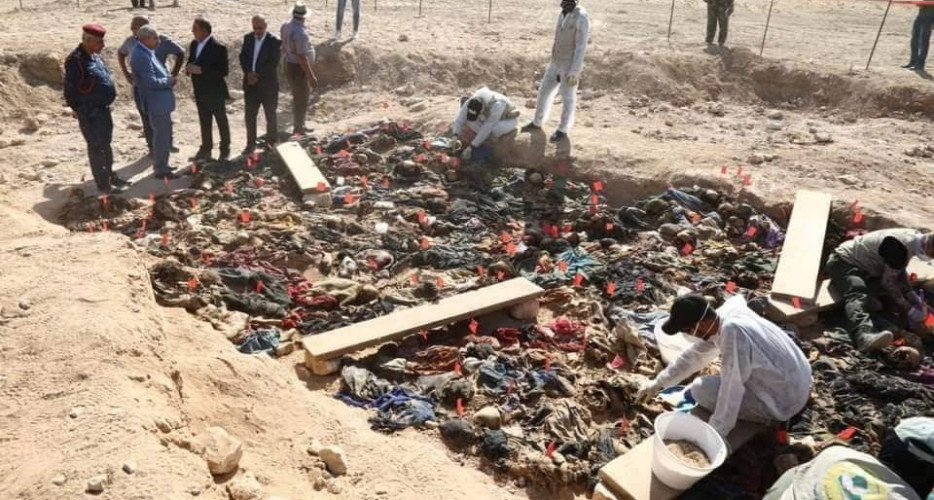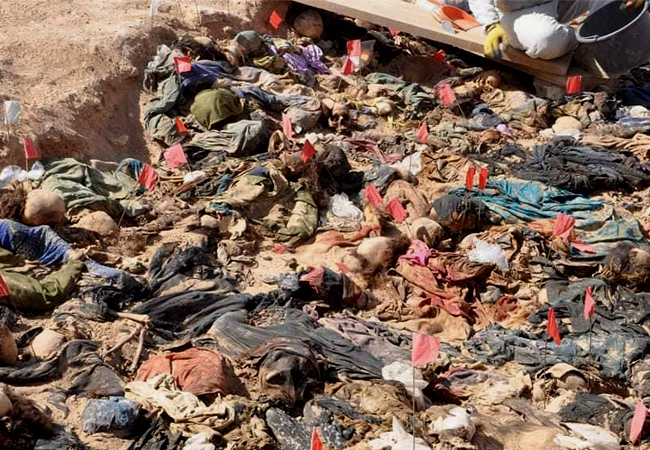
Peregraf- Haval Zangana
Hundreds of kilometers away from their homeland, Anfal victims were massacred on a desert land in exile. They have now been found after three decades, but are again being buried without identification or being brought back to their relatives.
Several months have passed since the remains of Kurdish Anfal victims have been kept in boxes on shelves at the Institute of Forensic Medicine in Baghdad and their relatives have not been recognized yet.
The Kurdistan Regional Government (KRG) intends to return the remains of the Anfal victims in order to rebury them in prepared graves in Chamchamal Province on Anfal Remembrance Day on April 14, 2020, without any identification process taking place.
The relatives of the victims cannot bear the fact that, after having waited for three decades, they are still unable to acknowledge the remains of their loved ones and have been deprived of the privilege to kiss their tombstones as no one knows which grave belongs to whom.
“I am saying this based on evidence, DNA tests are not being performed on the remains, and the Ministry of Martyr and Anfal Affairs is negligent. An agreement with the Martyrs Foundation in Baghdad was reached to exhume and return the graves in discreet”, said Taimour Abdulla.
Taimour, a lone survivor of the Anfal campaign, told Peregraf: “the Ministry of Martyr of KRG even doubts whether I am an Anfal survivor.”
The remains which have been agreed upon to be returned to Kurdistan Region are found in Samawah deserts located hundreds kilometers far in southern Iraq.

The mass grave of Kurdish women and children has been exhumed on July 27, 2019. Photo: Fouad Osman has sent to Peregraf.
Taimour is not only complaining about the absence of DNA tests, but also claims that the graves are not being scientifically exhumed and “were unearthed with shovels and excavators, distorting the shape of the crime.”
He had been to the site 20 days following the exhumation, and says: “several things like bones, hair, wallets and bullets had been left behind, I picked them up at the site and I had them recorded. But an officer from the Martyrs Ministry had said that Taimour had picked them up in a Kuwaiti mass grave. What on earth would a Kuwaiti soldier have wanted a baby feeding bottle for?!”
In Samawah Governorate, there are three Anfal mass graves. The exhumation of one of them started on 21 July, 2019, and contained the remains of 171 children and women.
According to Taimour, he is a survivor of that mass grave and those in the grave are his family, “there are many mass graves over there that I know of but am afraid of disclosing.”
“I am the only survivor of the Anfal genocide from my family and there are 110 people from my family and relatives in the grave. But up to this day, I have never been asked to provide my DNA sample to be used to examine and identify the remains.”
Taimour has opposed to returning the remains to Chamchamal. He says that they include his family and relative and should be taken to their birthplace in Garmyan.
The unearthed mass grave discloses many stories of the Kurdish genocide and the scene has been too tragic for many. “There was a blindfolded woman holding a newborn baby and was surrounded with six other children, a shoe belonging to a child was in the mother’s pocket. They were executed by firing squads. There were also backpacks, clothes, and the belongings of a newborn baby.”

The mass grave of Kurdish women and children has been exhumed on July 27, 2019. Photo: Fouad Osman has sent to Peregraf.
The Ministry of Martyrs and Anfal Affairs of KRG confirms that DNA tests have not been performed on the Anfal victims and their relatives.
Fuad Osman, spokesperson for the Ministry, said “these corpses are remains of 170 victims belonging to Samawah mass graves, and 2800 corpses have been previously returned.”
“Bone samples have been taken from the remains and the codes of the samples will be attached to the headstones. In the future, when DNA tests are performed for the samples and for the families, we will know which grave belongs to whom.”
According to Fuad Osman, the reason for not taking the tests for the time being is that “the process is too long, the expenses are high and it needs special teams and specific tools.”
Up to the fall of Ba’ath Regime headed by Sadam Hussain, some of the families of the Anfal victims held out hope that their lost relatives might still be alive and would return one day. For some years now, their only hope, especially for the lone survivors, is for DNA samples to be taken from them and the result to be saved until the return of the Anfal remains.
Salar Mahmood, counselor of the President of the Republic of Iraq, who closely oversaw the exhumation of the Samawah mass grave and followed the case in Forensic Medicine in Baghdad, said that there are flaws in the process. “DNA tests have not been performed on the victims’ families to be compared to those of the remains”, he told Peregraf.
He believes that it is a problem that concerns both the KRG and Iraqi Government, “it is a flaw and a negligence towards the long-awaited demand of the victims’ families”, he said.
He also mentioned that according to mass grave regulations, a monument should be built in the place of any exhumed mass grave to commemorate the victims.
“But this has not been done in Samawah deserts, which is a flaw.” He also believes that the team which is responsible for searching and exhuming the graves need more help and require adequate tools as their task is not easy.
The counselor requests international NGOs to closely supervise the process of examining and exhuming the mass graves.
Among 182000 victims of the Anfal and Barzani genocides, only the remains of 2500 victims have been returned to Kurdistan Region from the deserts of the middle and south of Iraq, which are buried under the Anfal monuments.

Salar Mahmood looks at the remnants of an Anfal victim
Dr Hunar Amin, PhD-holder in International Crime Law, told Peregraf: “one of the primary steps of recognizing a crime as genocide is by collecting evidences and documents on the victims; one of the significant evidences for the Kurds is those remains.”
According to Hunar, documenting the remains needs DNA tests to prove that the victims were Kurds, and then the results can be used in court even after 100 years.
“The Kurds have many documents to prove Anfal, and the documents will be complete with DNA tests.”
The International Crime Law expert suggests that by any means and at any cost the DNA tests should be performed on the remains to recognize them, if not, the case shall be weakened.
The Anfal Campaign lasted seven months in 1988, from February to September. During that period, the Ba’ath Regime displaced and executed 182000 Kurds in eight different provinces of Kurdistan in six stages, in addition to demolishing thousands of villages.